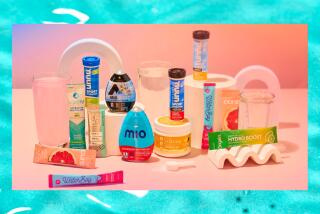Too Much Water Can Harm Athletes
- Share via
Kelly Hall, 34, was in fantastic shape, routinely biking 100 to 200 miles a week in preparation for last year’s AIDS Ride from Boston to New York. Usually, she trained with other riders, who made it a point to take food and hydration breaks. But one day last June, Hall decided to ride alone, despite the 95-degree heat.
The first 50 miles, around Concord, Mass., were a breeze. “I thought I’d do another 25,” she recalls. She drank a little Gatorade, a sports drink designed to restore normal blood levels of electrolytes, but relied mostly on water, constantly sipping from the 70-ounce CamelBak water supply on her back.
Halfway through the last loop, hyponatremia, a relatively rare but potentially fatal condition in which blood levels of sodium sink dangerously low, “hit like a ton of bricks,” says Hall. She finished her ride “really, really slowly,” got back to her car, threw up, drove home and threw up again. She made it to Brigham and Women’s Hospital, where she had a grand mal seizure.
Nearly the same thing happened to Sarah Snyder, 45, who was training with friends for another long, benefit ride. She, too, was in good condition and, she too, dutifully sipped water for 56 miles.
But after her ride, she threw up violently and was rushed to the hospital, where she drifted in and out of consciousness for 18 hours. “You drank too much water. You screwed up your sodium,” the doctors told her.
Full-blown cases of hyponatremia (sometimes called water intoxication) are relatively rare, roughly 0.1% to 4% of people who sweat steadily for hours in grueling, long-distance events, says Scott Montain, a research physiologist at the U.S. Army Research Institute of Environmental Medicine. The incidence of hyponatremia appears to be highest in events lasting more than four hours, especially at high temperatures. But the prevalence of warning symptoms is much higher--up to 27% of athletes who seek attention in a medical tent during a long race.
Typically, conscientious athletes get in trouble because they adhere too diligently to one recommendation (drink lots of fluids) but ignore another (keep electrolytes up). (Electrolytes are charged particles such as sodium, potassium, calcium and bicarbonate that must be kept in near-perfect balance). For most marathoners, Montain says, the real problem is drinking too much water, not failing to take in enough sodium.
Women in particular, may be at risk, some researchers believe, in part because they may be too dutiful about drinking water.
“When you sweat, you lose both water and salt,” says Dr. Soheyla Gharib, medical director of the women’s health center at Brigham and Women’s Hospital. “If you replace only water, the salt level in the blood gets diluted.”
And that can be disastrous. Normally, the body tries to keep positively and negatively charged electrolytes in balance to keep cells electrically neutral, says Dr. Ronenn Roubenoff, associate professor of medicine and nutrition and director of human studies at the Jean Mayer USDA Human Nutrition Research Center at Tufts University. Though sodium is probably the most important electrolyte for endurance athletes to worry about, he says, “an imbalance of any one of the electrolytes can be harmful.”
Normally, sodium is plentiful in the blood and relatively low inside cells. But when the concentration in the blood gets too low compared to the amount inside cells--either because a person drank too much water, took in too little sodium, or both--water rushes into cells. “Water follows sodium as day follows night,” Roubenoff says.
The result is dangerous swelling--particularly in the brain--that can lead to brain damage, coma and death. Curiously, hyponatremia can occur whether a person is dehydrated, normally hydrated or overhydrated because any of those conditions can happen while blood levels of sodium are too low, adds Roubenoff.
Further complicating things is that the symptoms of hyponatremia can be easily confused with those of heatstroke and heat exhaustion. With heat exhaustion (also called exertional heat injury), people feel ill, become nauseated, have muscle cramps and may feel dizzy standing up quickly. With heatstroke, people have all those symptoms plus mental status changes--that is, confusion about who and where they are and what day it is. People with genuine heatstroke also typically have extremely high body temperatures.
With hyponatremia, people also feel very ill and may have mental status changes but don’t have the high temperatures of heatstroke. They also vomit forcefully and repeatedly and, unlike those with heat exhaustion, do not feel better by resting and cooling off.
Treatment of hyponatremia may involve restricting fluid intake and promoting urine production, but some people also need intravenous saltwater (saline) with a high concentration of salt, until blood electrolytes return to normal. Resetting the water-salt balance “must be done carefully and slowly,” cautions Dr. Gabriel Danovitch, professor of medicine at UCLA School of Medicine, because overly rapid correction of electrolyte imbalance can cause further problems.
As dangerous as the condition is, even people like Snyder and Hall who wind up with severe hyponatremia can have happy endings. Snyder “feels as good as new” and has stockpiled sports drinks and plans to get back to biking soon.
And Hall? She did give up biking for the rest of last summer, but the consolation was that she had more time to plan her wedding.
*
udy Foreman is a lecturer on medicine at Harvard Medical School. She can be reached at judyforeman@attbi.com. Her column appears occasionally in Health.
More to Read
Sign up for Essential California
The most important California stories and recommendations in your inbox every morning.
You may occasionally receive promotional content from the Los Angeles Times.









